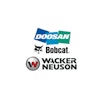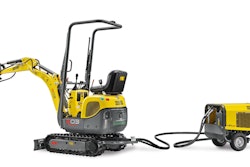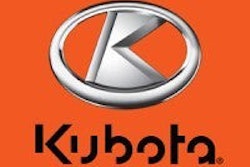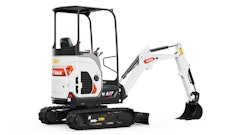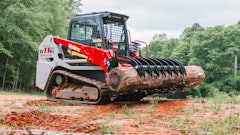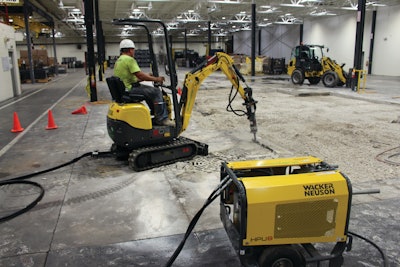
Unique features address the challenges of using compact excavators indoors or in confined spaces. These include foldable ROPS, variable-width undercarriages, non-marking tracks, air purifiers/scrubbers and alternative power systems.
The proper choice of machine and features depends on the particular job. “A contractor should do some homework before purchasing,” says Keith Rohrbacker, construction equipment product manager, Kubota. “Measure out the smallest areas the compact excavator will need to maneuver in or pass through, including maximum height. The last thing you want to happen is to realize halfway through a job that your excavator is too big. Once you have solid dimensions, narrowing down the machine options is much easier.”
Match to Jobsite Restrictions
“The most important considerations for operating indoors are the dimensions of the access point, the emissions regulations on the jobsite and any special safety considerations,” says Adam Purcell, product specialist, Wacker Neuson. “Some of the features that make Wacker Neuson mini-excavators well suited for interior applications are their compact size, zero tail turning radius and rubber tracks.
“The compact size allows our excavators to access small interior spaces,” he explains, “and the zero tailswing design reduces the likelihood of damage while working. Even our conventional tail turning radii have advantages for interior applications since they are narrower than zero tailswing machines, allowing them to drive through small doors.”
Often, indoor or confined space applications have specific restrictions listed in the bid, such as maximum machine operating weight, zero emissions or set noise limits. “Always consider the job restrictions first and foremost before bidding a job,” says Kendall Aldridge, vice president of sales and operations, IHI Compact Excavator Sales LLC.
Even if there are no restrictions in the bid terms, it may be prudent to select machines with low emissions levels when working indoors or in confined spaces. Not all machines are created equal when it comes to emissions.
“Do some research and compare the emissions levels produced by your excavator and make sure you’re making the smartest choice,” says Rohrbacker.
Power options exist to meet any jobsite restrictions. “The first consideration is if the contractor can use a diesel unit with an air purifier/scrubber or an electric unit needs to be used,” says Aldridge. “The next consideration would be the size of the unit that needs to be used. The digging depth that needs to be obtained and the height/width limitations would be the next important aspects of the job.”
Track Considerations
Consider how the machine is going to traverse the jobsite. Rubber tracks are pretty much a requirement on finished surfaces. “Rubber tracks are easier on the finished floors than their steel counterparts,” says Purcell.
Yet, not all rubber tracks are the same. “There are two different types of tracks that we offer for the electric units,” says Aldridge. “Both styles are made by Bridgestone and are original OEM tracks. The standard track is good for everyday use and applications. For buildings with existing concrete floors, a non-marking track may be required so a contractor can get into the building and do the work without scarring or marking up the floor.”
Track width is also important when it comes to indoor applications. “The Takeuchi TB216 features a 9-in. track width, which reduces overall ground pressure to only 4.3 psi,” says David Steger, national product and training manager, Takeuchi. “This is an important consideration for operating inside of a structure where machinery could potentially damage the floor.”
Track design can also contribute to the overall noise generated. “You definitely want the advantage of tracks with low noise when working indoors,” says Rohrbacker. “The Kubota U25S features upper track rollers that prevent tracks from hitting the frame while the machine is moving, not only reducing noise but also vibration, improving operator comfort and reducing fatigue.”
Ensure Attachment Compatibility
Many indoor tasks are specifically suited to compact excavators. “A major application for indoor use of mini-excavators is demolition work,” says Alderidge. “IHI/Compact Excavator Sales offers hydraulic hammers that can fit the 9VXE or the 17VXE electric excavators. Also used for concrete removal is The Beak. It is made by Daniel Mfg. and operates like a hydraulic thumb, clamping onto concrete slabs or debris for removal.”
To facilitate the use of hydraulic attachments, you need to ensure the proper hydraulic system plumbing and cooling are present. “All IHI excavators come standard with hydraulic piping to the end of the stick,” says Alderidge. “This allows the contractor to run an array of hydraulic attachments that best suit the job at hand.”
Precision is also important when working in close quarters. “Imperative when using hammer attachments at an indoor site, compact excavators offer compact size to fit into smaller spaces, precise control and smooth maneuvering, giving the operator the ability to hit with accuracy and efficiency,” says Rohrbacker. “A hydraulic oil cooler on Kubota compact excavators helps maintain proper heat balance of the oil while hammer attachments are in use. The KX-Series further maximizes performance with a hydraulic matching system and large capacity, variable-displacement pumps, providing the precise control needed when using hammer attachments.”
Working in Tight Spots
In tight spaces, maneuverability is critical to accomplishing the task at hand.
“When there is literally no room for error, the most important features come down to maneuverability, versatility and precise operation,” says Rohrbacker. Zero tailswing, variable-width tracks and precise hydraulic systems offer advantages.
The 360° rotating house on a compact excavator eliminates the need to reverse and readjust the machine in a tight space in order to use attachments in different directions or locations. “A long reach also enables operators to reposition less often when space is at a premium, greatly improving productivity,” says Rohrbacker.
Telescoping tracks allow access to tight areas while allowing track width to expand for increased performance. “Narrow machine width and telescoping tracks are the most important features in ensuring our excavators can access tight spaces during both interior and exterior applications,” says Purcell. “Because we know working in tight spaces is a common application for mini-excavators, Wacker Neuson offers four models with telescoping tracks: the 803, 1404, EZ17 and ET20 excavators.”
He adds, “The 803 1-tonne excavator has a variable width from 27.5 to 34 in., and the 1404, EZ17 and ET20 excavators have variable width from 39 to 51 in. With all of these excavators, it is very easy to change the track width, and Wacker Neuson excavators are designed so the operator can expand or retract the tracks while driving the machine.”
IHI/Compact Excavator Sales offers two models of zero tailswing electric compact excavators. “Both units come standard with expandable/retractable track frames,” says Aldridge. “The 9VXE has a track frame width of 38.5 in. when it is expanded and 27.5 in. when it is retracted. The 17VXE has a track frame width of 50 in. when it is expanded and 30 in. when it is retracted. Both feature a simple lever that can be flipped so the contractor can expand or retract the track frame on the fly.”
Kubota excavator track gauges can also be adjusted on the fly without having to lift the machine off the ground. “The KX018-4 and U17 track frames can be retracted to 3 ft. 3 in. to pass through narrow doorways and then extended for optimal stability when using heavy attachments,” says Rohrbacker. “The K008-3 is even more versatile in compact spaces with an adjustable track frame that can be reduced to 2 ft. 4 in., enabling passage through smaller doorways and gates. Plus, blade width adjustment is simple and requires only the removal of a single pin by hand — no tools required.”
Takeuchi advises that you not only ask about the retracted widths of the tracks but the fully extended width, as well. “Our TB216 Tier 4 compact excavator weighs just over 3,900 lbs. and features a 51.2-in. track width that is retractable down to 38.6 in.,” says Steger. “If you need something even more compact, we offer the TB108. It features a 35.4-in. track width that can retract to just 29.1 in. That’s narrow enough to fit through most standard interior doors in a commercial building.”
Anything you can do to help the operator perform the task without having to worry about incidental damage is beneficial. Zero tailswing excavators can alleviate stress for operators in confined spaces. “The zero tailswing of the Kubota U17 and U25S means you never have to worry about obstacles beside or behind your machine; the tail always stays within the width of the track no matter how far you turn,” says Rohrbacker. “The zero swing also means the operator will experience excellent balance and stress-free productivity — important factors when working within the constraints of an indoor site.”
Folding ROPS can also prove beneficial in close quarters. “Wacker Neuson features a foldable ROPS system on the 803 1-tonne excavator,” says Purcell. “The system is easy to use by simply removing a couple of bolts, allowing the operator to quickly fold down the ROPS structure.”
Other manufacturers also offer this feature. “Kubota offers a foldable ROPS on its KX008-3, combining safety, convenience, and making entry to some of the tightest work spaces possible,” says Rohrbacker.
In some instances, manufacturers have designed the ROPS to fit through a standard doorway without folding. “Our units come with a standard bolt-on four-post canopy,” says Aldridge. “The height of the 9VXE allows the contractor to maneuver through a standard door without having to remove the four-post canopy.”
Consider Air Restrictions
Air quality is an important issue when working indoors or in confined spaces.
“While Kubota does not offer electric or propane-powered excavators, our Tier 4 Kubota-Clean Diesel Solution (K-CDS) engines have been shown to produce significantly lower NOx emissions and less particulate matter,” says Rohrbacker. “Both particulate matter and NOx emissions are known to be harmful to not only the ozone [layer], but to the operator and anyone else close enough to inhale them.”
Tier 4 equipment does offer significant benefits. “The EPA Tier 4 machines have drastically improved diesel emissions, reducing the amount of NOx and particulate matter to the point that it is much safer to operate these new machines in indoor applications,” says Rohrbacker.
Diesel-powered excavators also provide a cost advantage in many applications. “A diesel mini-excavator is going to be more cost effective than using an electric unit as far as the rental rates, but only if electric or propane are not required power. IHI/Compact Excavator offers electric units suitable for all applications and needs,” says Aldridge.
If diesel-powered equipment is permitted, it may be wise to ensure adequate ventilation via the use of an air purifier/scrubber and possibly a CO2 detector. Air purifiers/scrubbers have become commonplace in the industry.
“IHI/Compact Excavator Sales has been offering air purifiers/scrubbers for many years for contractors doing indoor construction,” says Aldridge. “[We] introduced the first electric mini-excavator into the market in 2004 due to demand from the concrete sawing and drilling industry. Now, we have two different models of electric mini-excavators — the 9VXE (2,000-lb. unit) and 17 VXE (3,500-lb. unit).”
The 9VXE electric unit can be equipped with a single-phase 208- or 230-volt or three-phase 480-volt Baldor engine. The 17 VXE is powered by a three phase 480-volt, 15-hp Rueland motor. “The electric units come with 100 ft. of cord and can be plugged into a generator or hard wired in the building for use,” says Aldridge.
Takeuchi also displayed the TB117e electric-powered compact excavator at CONEXPO-CON/AGG 2011. Currently, this model is only available overseas.
Typically, electric units are used on jobsites that restrict anything but electric or propane. “In some cases, propane is not even allowed — for example, hospitals, grocery stores, power plant shutdowns, etc.,” says Aldridge. “It depends on what the OSHA restrictions are for the job.”
To address this, manufacturers are looking at solutions that combine diesel and electric power. “Our new Wacker Neuson 803 Dual Power 1-tonne excavator is specifically designed for interior applications and allows the machine to operate emissions-free while working indoors,” says Purcell. “This machine features both a standard diesel engine for exterior applications and uses an electrohydraulic pump to operate indoors. This machine is perfectly tailored to the needs of indoor applications, while still allowing the operator to use the standard diesel engine when working outdoors.” The excavator delivers the same performance regardless of the power source being used.
“Our dual power design allows the contractor or rental company to maximize the utility of the machine regardless of the application,” says Purcell. “It’s ideal for the current state of the market where most electric-only excavators sit unused a large percentage of the time.”
Although an important application, Steger advises looking beyond indoor use when acquiring an excavator. “If you are planning on purchasing, take a close look at the power of the machine, as well,” he says. “Compact excavators are excellent tool carriers for indoor applications. But if a contractor is making an investment, they will want to look for a more versatile machine that can work in other applications on the jobsite, as well.”




